Cisco® 400-051 Exam Practice Questions (P. 4)
- Full Access (939 questions)
- Six months of Premium Access
- Access to one million comments
- Seamless ChatGPT Integration
- Ability to download PDF files
- Anki Flashcard files for revision
- No Captcha & No AdSense
- Advanced Exam Configuration
Question #31
Which H.245 information is exchanged within H.225 messages in H.323 Fast Connect?
- ATerminal Capability Set
- BOpen Logical Channel
- CMaster-Slave Determination
- DCall Setup
- ECall Progress
Correct Answer:
B
With the standard H.245 negotiation, the two endpoints need three round-trips before they agree on the parameters of the audio/video channels (1. master/slave voting, 2. terminal capability set exchange, and finally, 3. opening the logical channels). In certain situations and especially with high-latency network links, this can last too long and users will notice the delay.
B
With the standard H.245 negotiation, the two endpoints need three round-trips before they agree on the parameters of the audio/video channels (1. master/slave voting, 2. terminal capability set exchange, and finally, 3. opening the logical channels). In certain situations and especially with high-latency network links, this can last too long and users will notice the delay.
send
light_mode
delete
Question #32
Which two compression formats for high-definition video have technical content that is identical to H.264? (Choose two.)
- AMPEG-4 Part 10
- BMPEG-4 Part 14
- CMPEG-2 Part 7
- DAVC
- EVC3
- FVP8
Correct Answer:
AD
MPEG-4 Part 10, also known as MPEG-4 AVC (Advanced Video Coding), is actually defined in an identical pair of standards maintained by different organizations, together known as the Joint Video Team (JVT). While MPEG-4 Part 10 is a ISO/IEC standard, it was developed in cooperation with the ITU, an organization heavily involved in broadcast television standards. Since the ITU designation for the standard is H.264, you may see MPEG-4 Part 10 video referred to as either
AVC or H.264. Both are valid, and refer to the same standard.
AD
MPEG-4 Part 10, also known as MPEG-4 AVC (Advanced Video Coding), is actually defined in an identical pair of standards maintained by different organizations, together known as the Joint Video Team (JVT). While MPEG-4 Part 10 is a ISO/IEC standard, it was developed in cooperation with the ITU, an organization heavily involved in broadcast television standards. Since the ITU designation for the standard is H.264, you may see MPEG-4 Part 10 video referred to as either
AVC or H.264. Both are valid, and refer to the same standard.
send
light_mode
delete
Question #33
Refer to the exhibit.

A user is going through a series of dialing steps on an SCCP IP phone (extension 1001) to call another SCCP IP phone (extension 2003). Both phones are registered to the same Cisco Unified Communications Manager cluster. Which user inputs are sent from the calling IP phone to the Cisco Unified Communications
Manager, in forms of SCCP messages, after the user pressed the Dial softkey? Note that the commas in answer choices below are logical separators, not part of the actual user input or SCCP messages.

A user is going through a series of dialing steps on an SCCP IP phone (extension 1001) to call another SCCP IP phone (extension 2003). Both phones are registered to the same Cisco Unified Communications Manager cluster. Which user inputs are sent from the calling IP phone to the Cisco Unified Communications
Manager, in forms of SCCP messages, after the user pressed the Dial softkey? Note that the commas in answer choices below are logical separators, not part of the actual user input or SCCP messages.
- AA separate SCCP message is sent to Cisco Unified Communications Manager for each of the following user inputs: 2, 0, 0, 3.
- BA separate SCCP message is sent to Cisco Unified Communications Manager for each of the following user inputs: 2, 0, 1, <<, 0, 3.
- CA single SCCP message is sent to Cisco Unified Communications Manager to report that digits 2003 have been dialed.
- DA single SCCP message is sent to Cisco Unified Communications Manager to report that digits 201<<03 have been dialed.
- EA separate SCCP message is sent to Cisco Unified Communications Manager for each of the following user inputs: 2, 0, 1, <<, 2, 0, 0, 3.
Correct Answer:
C
After the user delete phone stop the digit by digit dialing and send it as a whole setup.
C
After the user delete phone stop the digit by digit dialing and send it as a whole setup.
send
light_mode
delete
Question #34
How are DTMF digits transported in RFC 2833?
- AIn the RTP stream with the named telephone events payload format.
- BIn the RTP stream with the regular audio payload format.
- CIn SIP NOTIFY messages.
- DIn SIP INFO messages.
- EIn SIP SUBSCRIBE messages.
Correct Answer:
A
DTMF digits and named telephone events are carried as part of the audio stream, and MUST use the same sequence number and time-stamp base as the regular audio channel to simplify the generation of audio waveforms at a gateway. The default clock frequency is 8,000 Hz, but the clock frequency can be redefined when assigning the dynamic payload type.
A
DTMF digits and named telephone events are carried as part of the audio stream, and MUST use the same sequence number and time-stamp base as the regular audio channel to simplify the generation of audio waveforms at a gateway. The default clock frequency is 8,000 Hz, but the clock frequency can be redefined when assigning the dynamic payload type.
send
light_mode
delete
Question #35
Refer to the exhibit.

Which DTMF relay method is advertised when the originating SIP gateway sends an INVITE message with a Call-Info header shown?

Which DTMF relay method is advertised when the originating SIP gateway sends an INVITE message with a Call-Info header shown?
- ARFC 2833
- BSIP INFO
- CSIP NOTIFY
- DSIP KPML
- EIn-band audio
Correct Answer:
C
You can develop user-specific applications that reside on your network entity and have the ability to subscribe for event services supported by the IMG. If the network entity wants the ability to detect an entered DTMF digit (only telephone event of "###" are currently supported) from the TDM-side of a call to the IP side of a call, the entity can subscribe to the IMG for these events and receive SIP NOTIFY events containing the digit event.
C
You can develop user-specific applications that reside on your network entity and have the ability to subscribe for event services supported by the IMG. If the network entity wants the ability to detect an entered DTMF digit (only telephone event of "###" are currently supported) from the TDM-side of a call to the IP side of a call, the entity can subscribe to the IMG for these events and receive SIP NOTIFY events containing the digit event.
send
light_mode
delete
Question #36
Refer to the exhibit.
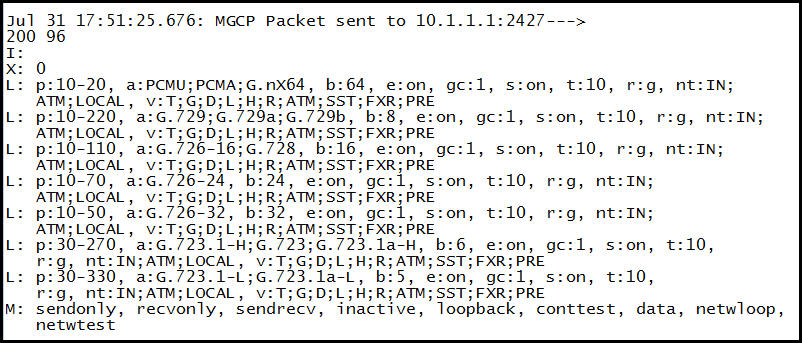
You received this debug output to troubleshoot a Cisco IOS MGCP gateway problem at a customer site. What is the purpose of this message?

You received this debug output to troubleshoot a Cisco IOS MGCP gateway problem at a customer site. What is the purpose of this message?
- AThe MGCP gateway uses this message to respond to an RQNT message from Cisco Unified Communications Manager.
- BThe MGCP gateway uses this message to respond to an AUCX message from Cisco Unified Communications Manager.
- CThe MGCP gateway uses this message to respond to an AUEP message from Cisco Unified Communications Manager.
- DThe MGCP gateway uses this message to respond to a DLCX message from Cisco Unified Communications Manager.
- EThe MGCP gateway uses this message to respond to an NTFY message from Cisco Unified Communications Manager.
Correct Answer:
C
This message requests the status of an endpoint. Information that can be audited with this includes Requested
Events,DigitMap,SignalRequests,RequestIdentifier,QuarantineHandling, Notified Entity, Connection Identifiers, Detect Events, Observed Events, Event States,
Bearer Information, Restart Method, Restart Delay, ReasonCode, PackageList, Max MGCP Datagram, and Capabilities. The response will include information about each of the items for which auditing info was requested.
C
This message requests the status of an endpoint. Information that can be audited with this includes Requested
Events,DigitMap,SignalRequests,RequestIdentifier,QuarantineHandling, Notified Entity, Connection Identifiers, Detect Events, Observed Events, Event States,
Bearer Information, Restart Method, Restart Delay, ReasonCode, PackageList, Max MGCP Datagram, and Capabilities. The response will include information about each of the items for which auditing info was requested.
send
light_mode
delete
Question #37
Refer to the exhibit.
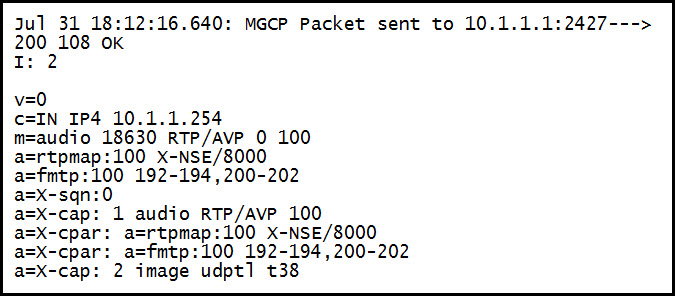
You received this debug output to troubleshoot a Cisco IOS MGCP gateway call quality issue at a customer site. Which statement about this message is true?

You received this debug output to troubleshoot a Cisco IOS MGCP gateway call quality issue at a customer site. Which statement about this message is true?
- AThe MGCP gateway is responding to an RQNT message from Cisco Unified Communications Manager to poll the call statistics of an active call.
- BThe MGCP gateway is responding to an AUEP message from Cisco Unified Communications Manager to poll the call statistics of a terminating call.
- CThe MGCP gateway is responding to an MDCX message from Cisco Unified Communications Manager during a call setup.
- DThe MGCP gateway is responding to an AUCX message from Cisco Unified Communications Manager about an active call.
- EThe MGCP gateway is responding to a DLCX message from Cisco Unified Communications Manager about a terminating call.
Correct Answer:
E
DeleteConnection used by a call agent to instruct a gateway to delete an existing connection. DeleteConnection can also be used by a gateway to release a connection that can no longer be sustained.
E
DeleteConnection used by a call agent to instruct a gateway to delete an existing connection. DeleteConnection can also be used by a gateway to release a connection that can no longer be sustained.
send
light_mode
delete
Question #38
Refer to the exhibit.
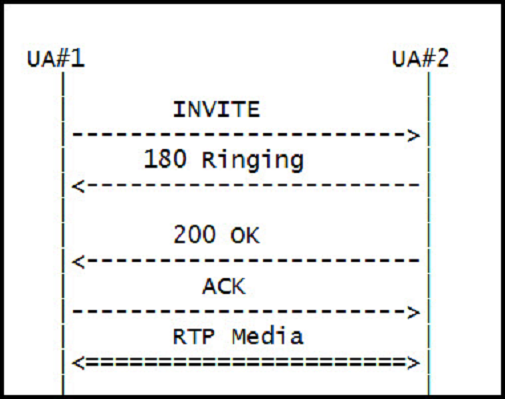
If this SIP call is initiated using delayed offer, which SIP message will UA#2 use to communicate its media capability to UA#1?

If this SIP call is initiated using delayed offer, which SIP message will UA#2 use to communicate its media capability to UA#1?
- AINVITE
- B180 Ringing
- C200 OK
- DACK
- ERTP Media C
Correct Answer:
Explanation
200 OK Indicates the request was successful.
Explanation
200 OK Indicates the request was successful.
send
light_mode
delete
Question #39
To which SIP response category does 301 Moved Permanently belong?
- AProvisional
- BSuccessful
- CRedirection
- DClient Failure
- EServer Failure
Correct Answer:
C
The 301 response from the Web server should always include an alternative URL to which redirection should occur. If it does, a Web browser will immediately retry the alternative URL. So you never actually see a 301 error in a Web browser, unless perhaps you have a corrupt redirection chain e.g. URL A redirects to
URL B which in turn redirects back to URL A. If your client is not a Web browser, it should behave in the same way as a Web browser i.e. immediately retry the alternative URL.
C
The 301 response from the Web server should always include an alternative URL to which redirection should occur. If it does, a Web browser will immediately retry the alternative URL. So you never actually see a 301 error in a Web browser, unless perhaps you have a corrupt redirection chain e.g. URL A redirects to
URL B which in turn redirects back to URL A. If your client is not a Web browser, it should behave in the same way as a Web browser i.e. immediately retry the alternative URL.
send
light_mode
delete
Question #40
Refer to the exhibit.
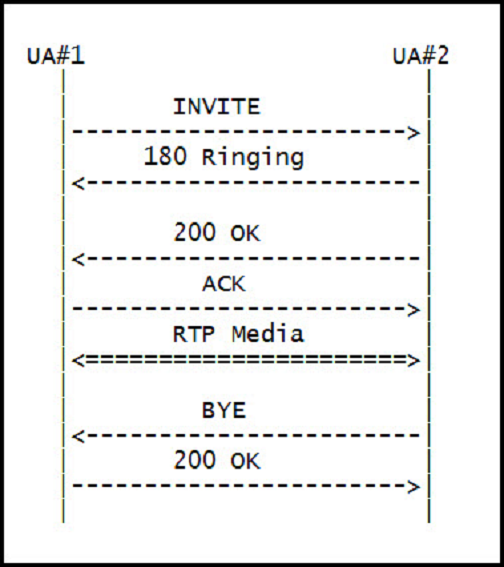
How many SIP signaling transaction(s) took place in this SIP message exchange between two SIP user agents?

How many SIP signaling transaction(s) took place in this SIP message exchange between two SIP user agents?
- A1
- B2
- C3
- D4
- E5
- F6
Correct Answer:
C
During the establishment, maintenance and termination of a SIP session, signaling messages are exchanged between the two SIP endpoints. There are two different kinds of signaling "conversations" that those messages take part in: transactions and dialogs.
A transaction is a SIP message exchange between two user-agents that starts with a request and ends with its final response (it can also contain zero or more provisional responses in between). For example, during the termination of a SIP session, one user releases the call by sending a BYE request and the other party replies back with a 200 OK response. This message exchange is called a transaction.
But what happens in the case of the INVITE request? The establishment of a SIP session starts basically with an INVITE request and is considered as completed upon the receipt of the ACK. In this case, the transaction starts with the INVITE request and ends with the 200 OK, so the ACK is not part of the transaction. The
ACK can be considered as a transaction on its own. However, when the final response to an INVITE is not a 2xx response, then the ACK is considered as part of the transaction. A dialog is a complete exchange of SIP messages between two user-agents. That means that transactions are actually parts of a dialog. For example, in the case of a SIP session establishment, a dialog starts with the INVITE-200 OK transaction, continues with the ACK and ends with the BYE-200 OK transaction.
The picture below depicts the dialog and transactions that take place during the establishment of a SIP session:
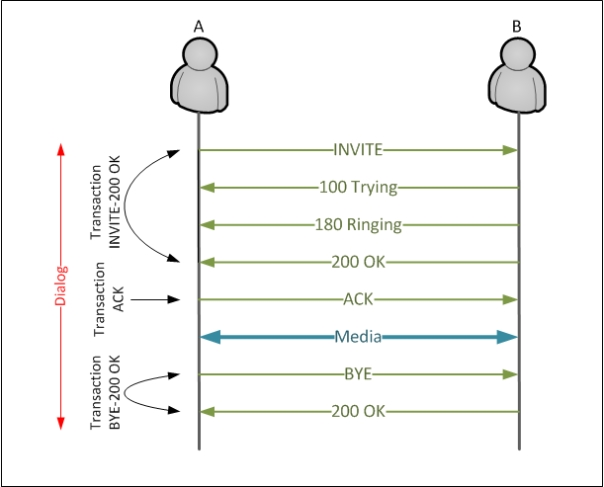
Note: There can also be subsequent requests that belong to the same dialog, such as a BYE or a re-INVITE message. As out-of-dialog requests are considered messages such as an initial INVITE request for a new session or an OPTIONS message for checking capabilities.
There are different SIP headers/parameters that identify the dialogs and transactions, and they will be analyzed in later posts.
References: https://telconotes.wordpress.com/2013/03/13/sip-transactions-vs-dialogs/
C
During the establishment, maintenance and termination of a SIP session, signaling messages are exchanged between the two SIP endpoints. There are two different kinds of signaling "conversations" that those messages take part in: transactions and dialogs.
A transaction is a SIP message exchange between two user-agents that starts with a request and ends with its final response (it can also contain zero or more provisional responses in between). For example, during the termination of a SIP session, one user releases the call by sending a BYE request and the other party replies back with a 200 OK response. This message exchange is called a transaction.
But what happens in the case of the INVITE request? The establishment of a SIP session starts basically with an INVITE request and is considered as completed upon the receipt of the ACK. In this case, the transaction starts with the INVITE request and ends with the 200 OK, so the ACK is not part of the transaction. The
ACK can be considered as a transaction on its own. However, when the final response to an INVITE is not a 2xx response, then the ACK is considered as part of the transaction. A dialog is a complete exchange of SIP messages between two user-agents. That means that transactions are actually parts of a dialog. For example, in the case of a SIP session establishment, a dialog starts with the INVITE-200 OK transaction, continues with the ACK and ends with the BYE-200 OK transaction.
The picture below depicts the dialog and transactions that take place during the establishment of a SIP session:

Note: There can also be subsequent requests that belong to the same dialog, such as a BYE or a re-INVITE message. As out-of-dialog requests are considered messages such as an initial INVITE request for a new session or an OPTIONS message for checking capabilities.
There are different SIP headers/parameters that identify the dialogs and transactions, and they will be analyzed in later posts.
References: https://telconotes.wordpress.com/2013/03/13/sip-transactions-vs-dialogs/
send
light_mode
delete
All Pages
